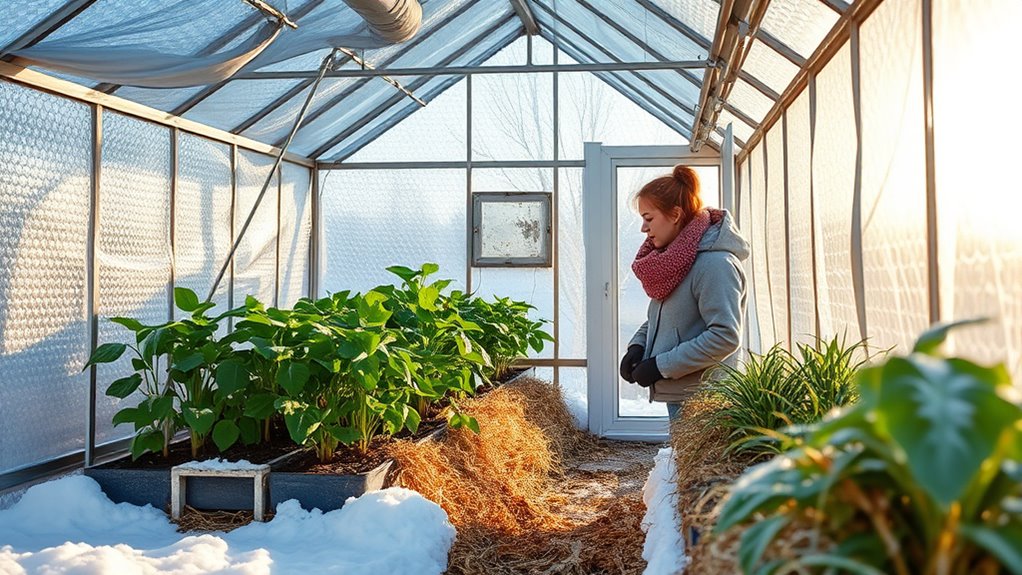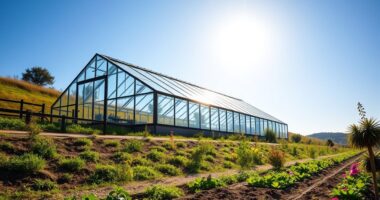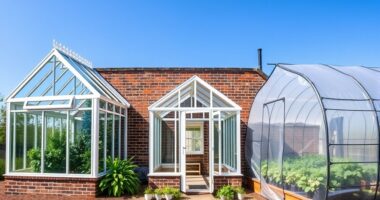To insulate your greenhouse for winter, start by using materials like horticultural bubble wrap and reflective thermal foil to retain heat. Install effective cladding options, such as double-glazed glass or polycarbonate panels, to trap warmth inside. Don’t forget DIY techniques like sealing gaps with silicone caulk and adding thermal mass with water containers or rocks. Managing airflow with ventilation systems is essential to prevent cold spots. Discover more tips for a cozy greenhouse environment ahead.
Key Takeaways
- Use horticultural bubble wrap on the interior walls to trap heat while allowing light to penetrate.
- Install double-glazed glass or twin-wall polycarbonate panels for superior insulation and reduced heat loss.
- Seal gaps and cracks with silicone caulk to prevent drafts and improve overall insulation efficiency.
- Utilize thermal screens or curtains at night to retain heat and minimize temperature fluctuations.
- Add mulch or straw on the ground to help retain soil warmth during cold winter months.
Essential Insulation Materials
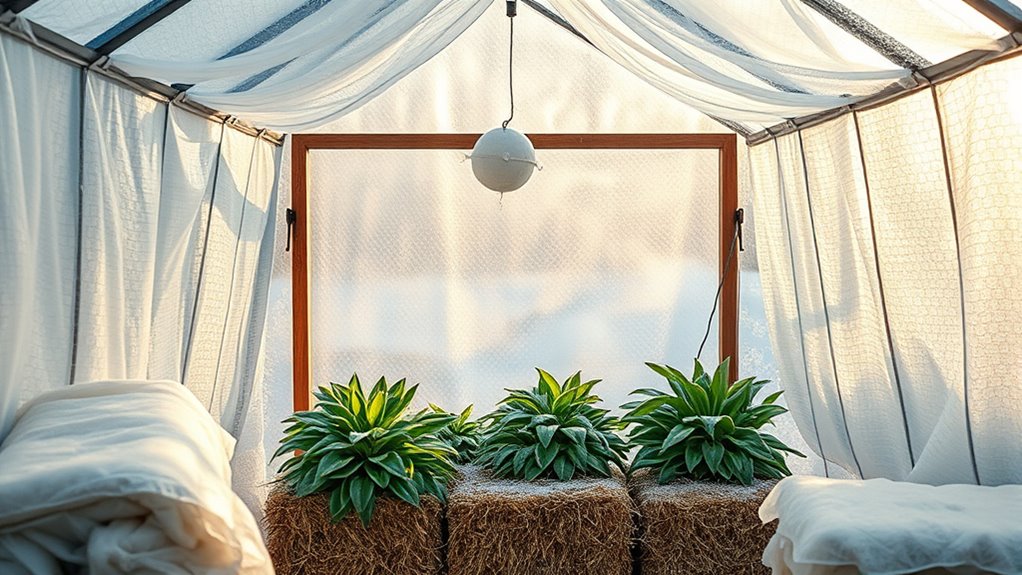
When winter approaches, choosing the right insulation materials for your greenhouse becomes essential to maintain a warm environment for your plants.
Horticultural bubble wrap is a fantastic option; it traps air in its bubbles while allowing light to enter, keeping heat inside. Reflective thermal insulation foil can effectively reduce heat loss by trapping warm air.
Consider thermal screens or curtains that you can draw at night for added warmth. Placing Styrofoam around the lower half of interior walls insulates effectively, while mulch or straw on the ground helps retain soil warmth.
Effective Cladding Options

Choosing the right cladding for your winter greenhouse is essential for maintaining a stable and warm environment for your plants.
Consider these effective options:
- Polycarbonate Panels: Lightweight, impact-resistant, and great for insulation.
- Double-Glazed Glass: Traps air between two panes for better insulation.
- Plastic Films: Affordable and often used in layered configurations for added warmth.
- Twin-Wall Polycarbonate: Offers enhanced insulation through its double-layer structure.
- Insulated Panels: Create a thermal barrier, especially useful for foundations.
Each of these materials can greatly improve heat retention and energy efficiency in your greenhouse.
DIY Insulation Techniques
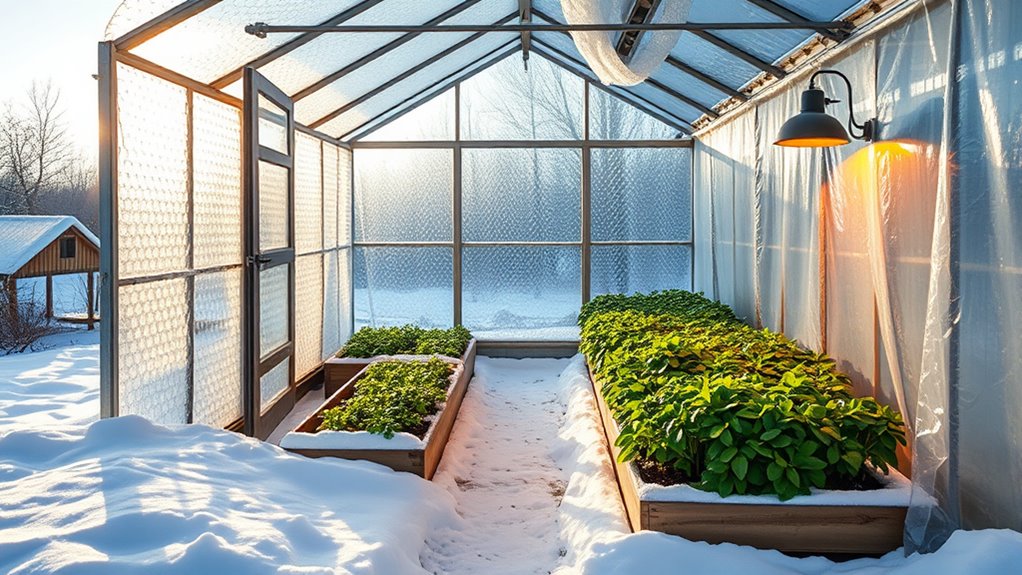
Insulating your greenhouse for winter doesn’t have to be complicated or expensive; there are several effective DIY techniques you can use. Here are some materials and methods to evaluate:
| Material/Technique | Description |
|---|---|
| Bubble Wrap | Provides thermal insulation while letting light through. |
| Water Containers | Stabilizes temperature by absorbing and releasing heat. |
| Silicone Caulk | Seals gaps and cracks to prevent heat loss. |
You can also use reflective materials like aluminum foil, or add thermal mass with rocks. Don’t forget to insulate specific areas like the roof and doors with bubble wrap or rigid foam panels. These simple steps can make a big difference in maintaining warmth!
Preparing Your Greenhouse Structure
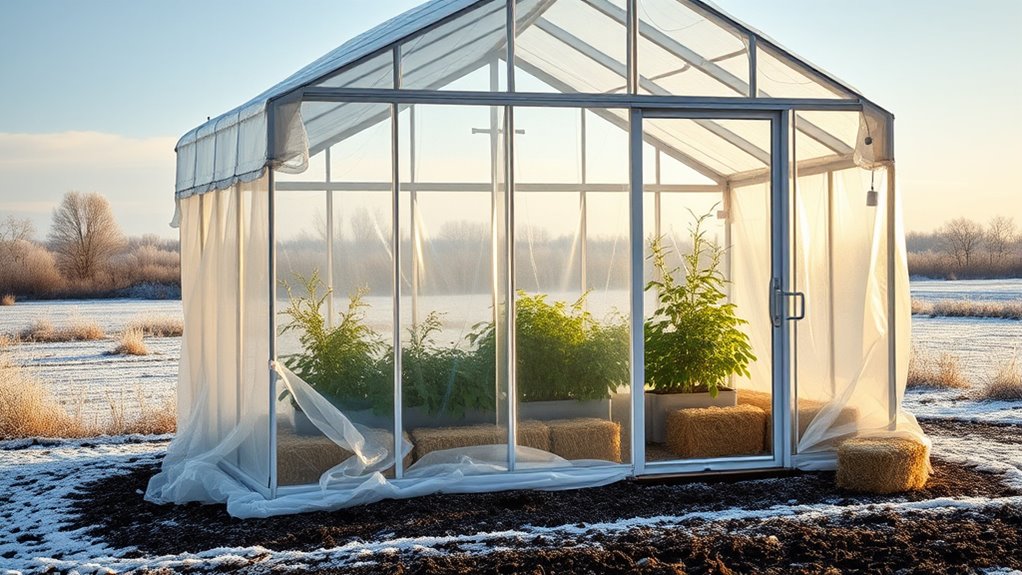
Preparing your greenhouse structure for winter is just as important as implementing effective insulation techniques. Start by taking the necessary steps to make certain your greenhouse is ready for the colder months.
Here are some key actions to take into account:
- Clean the greenhouse from top to bottom for a healthy environment.
- Inspect for damage, checking for broken equipment or cladding issues.
- Examine cladding for rips or holes that could compromise insulation.
- Ensure structural integrity to withstand heavy snow and harsh winds.
- Consider the R-value of cladding materials to enhance insulation efficiency.
Managing Temperature and Airflow
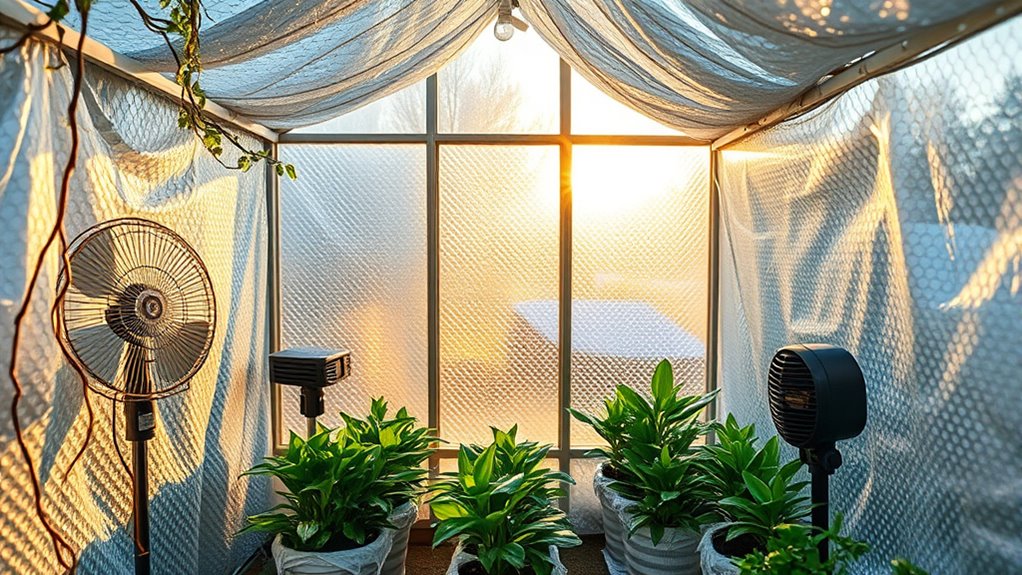
To guarantee your greenhouse thrives during winter, effectively managing temperature and airflow is essential.
Start by insulating your space with horticultural bubble wrap or double layers of plastic film, which help retain heat while allowing light in. Install thermal screens for added insulation and utilize insulating ground materials like straw to keep soil warm.
Ascertain proper airflow by using ventilation systems and fans to prevent cold spots and excess moisture. Regularly monitor the temperature and humidity levels, adjusting your heating systems as needed.
To further optimize conditions, seal any gaps to prevent heat loss, and consider adding thermal mass with water barrels to help stabilize temperatures. This way, you create a cozy environment for your plants.
Frequently Asked Questions
How Can I Determine My Greenhouse’s Ideal Insulation Level?
To determine your greenhouse’s ideal insulation level, start by evaluating your local climate and temperature fluctuations.
Consider the size and design of your greenhouse, as larger structures typically require more insulation.
Evaluate the types of plants you’re growing since their temperature needs will influence insulation requirements.
Finally, look into insulation materials, such as bubble wrap or thermal curtains, to enhance heat retention based on your specific conditions and plant needs.
What Are the Costs Associated With Different Insulation Methods?
When it comes to insulating your space, think of it like choosing your armor for a winter battle.
Different insulation methods come with varying costs. Polycarbonate panels might break the bank upfront but save you in the long run.
Double poly film is budget-friendly, while bubble insulation is easy to install but needs regular replacements.
Thermal insulation foil is cost-effective, and climate screens offer energy savings, albeit at a higher price.
Choose wisely!
How Often Should I Replace Insulation Materials?
You should replace insulation materials based on their lifespan, which varies by type and quality.
Regular inspections can help you identify signs of wear, like tears or decreased efficiency. If you live in a harsh climate, you might need to replace insulation more often.
Generally, check materials every few years and consult professionals for tailored advice.
Balancing cost with energy efficiency will guarantee your insulation remains effective for your specific needs.
Can I Use Multiple Insulation Methods Together?
Imagine your greenhouse wrapped in a cozy blanket of warmth, protecting your plants from winter’s chill.
Yes, you can definitely use multiple insulation methods together! Combining materials like bubble wrap with thermal foil enhances heat retention, while adding water containers or bricks boosts thermal mass.
This layered approach guarantees a stable environment, maximizing both heat and light.
What Plants Are Most Sensitive to Temperature Fluctuations?
When considering plant sensitivity to temperature fluctuations, you need to watch out for tropical and subtropical plants, as they’re highly vulnerable to cold snaps.
Young or newly planted specimens lack established roots, making them more susceptible to stress.
Flowering shrubs and trees also suffer from sudden temperature changes, which can damage buds and flowers.
Ultimately, psychrophiles thrive only in very specific temperature ranges, limiting their growth during fluctuations.
Conclusion
Insulating your greenhouse for winter isn’t just a smart move; it’s practically a superpower! With the right materials and techniques, you can transform your space into a tropical paradise amid the frost. Imagine your plants thriving while snowflakes dance outside, defying winter’s chill like a hero in a blockbuster movie. By prepping your structure and managing airflow, you’re not just protecting your plants—you’re crafting an oasis that keeps the cold at bay and lets your gardening dreams flourish!
